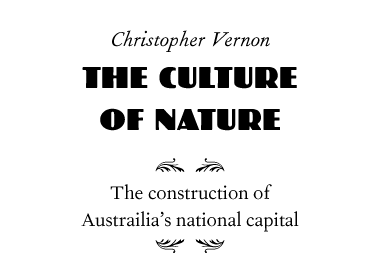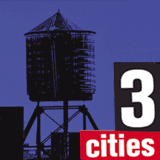 We see landscapes without their inhabitants. When we evoke a natural landscape in our minds' eye a featureless desert, perhaps, a range of snowy mountains, or a stretch of white sand, bordered by lush rainforest and cerulean sea and untouched by human feet we unconsciously imagine an unpopulated paradise. People are noisy, smelly, and unpredictable. People are untidy, littering the landscapes in which they live with their bothersome presence. Yet our landscapes only make sense to us because of the way we and many, many before us have learned to interpret our natural world. When we admire the dales and rolling hills of Britain's Lake District we admire Lake Windermere through Wordsworth's poetry. When we stand, open-mouthed, in Yosemite National Park we see Half Dome Mountain through the lens of Ansel Adams' camera. We may not know that we're doing this, but we are. Our eyes are not our eyes only, but the eyes also of those who have gone before us. Landscapes derive their meaning only because of our interaction with them. We are obliged, for good and ill, to see nature through culture. What, therefore, is the relationship of a city to its landscape? Despite being landscapes unique to themselves, cities can also be, like Wordsworth's poetry or Adams' photography, yet another medium through which man can come to understand his landscape. The natural basin of San Francisco Bay means nothing without the bridge. Sydney Harbour unimaginable without the Opera House. The winding progress of the Seine rendered meaningless without the Pont Neuf or Notre Dame. Ever since he started building cities, man has seen his landscape through their streets and from their rooftops. Rarely, however, has this been a conscious decision. Rarely has a city been constructed with the express purpose of both mimicking its natural setting and planting itself in it, its status as a city, a work of man, noisy, busy and smelly, still intact. Perhaps that is why Australia's national capital city Canberra is an ethereal, disturbing place. Here, the palpable sense of monumentality one expects in a national capital is imbued not by magnificent architectural ensembles but by the landscape itself. The city's landscape setting is so pre-eminent that Canberra is known as the 'bush capital' and was once promoted to tourists as the 'natural capital'. Contrary to the popular connotations of a 'bush' or 'natural' capital, Canberra is an entirely synthetic environment, a planned city begun on an open site in 1913. And the provocative pre-eminence of landscape at Canberra is achieved by design as well as by default, a purpose-built framing of its setting for the aesthetic enjoyment of its population. In 1901 the Commonwealth of Australia was formed by the federation of six of Great Britain's autonomous antipodean colonies. A desire to construct a new national capital city, a political 'act of faith', soon arose from this climate of reconfiguration. The capital was to occupy an open, largely pastoral site in the broad valley of the Molonglo River, inland from the eastern coast. Much contested, the site was identified owing to its roughly intermediate distance between the rival centres of Sydney and the temporary national capital, Melbourne. In 1911, a decade after its Federation, Australia launched an international design competition for its capital. When the competition closed on 31 January 1912, 137 entries had been received from within and outside the British Empire. In May, the plan of American landscape architect and architect Walter Burley Griffin (1876-1937), designed in collaboration with his wife Marion Mahony Griffin (1871-1961), was selected as the winner. The Griffins' sensitivity to the site's natural features, most notably its rugged landforms and watercourse, was paramount to their design's success. The couple organised the city on a cross-axial scheme, its alignment determined by the site's natural features. A 'Land Axis', for instance, was suggested by the linear correspondence of the summits of four local mounts. Perpendicular to this armature, they delineated a cross 'Water Axis', its path determined by the river course that in the plan was refashioned into a series of linked ornamental basins. Through their plan's structural dialogue with the site's topographical features and other attributes, the Griffins appropriated the physical site itself as the new nation's primal and enduring monument. Lacking the cultural artefacts and other monuments of human creation typical of the Old World capitals, in Canberra nature was to be their surrogate. Canberra's hills, for instance, became sacred points of reference in the Griffins' 'Land Axis'. Mount Ainslie would be their Notre Dame. As they actually prepared the design from a distance in Chicago, Canberra served as a conceptual and metaphorical bridge between the two nations. The impulse to monumentalise nature was a reaction to the Griffins' American experience. At the time of the Canberra competition, their native Chicago was a burgeoning metropolis in the midst of transformation by accelerating and largely unregulated urban and suburban expansion. The city's formerly open natural and agricultural surrounds quickly metamorphosed into speculatively motivated city extensions and new suburbs. Walter and Marion Griffin envisaged Canberra as a designed alternative to the urban indifference to the natural world that they saw in Chicago. For them, Australia provided an opportunity to perfect lessons learnt from America's shortcomings, and designed landscape became a habitable 'second' nature, one referential to its more remote, primeval counterpart. In Canberra, the Griffins set out to make a national, cultural history from natural history. Coincidentally, the Griffins' aims proved compatible with contemporary Australian sensibilities. Owing to the relative insignificance of human presence in the vastness of Australia, it was the indigenous bush, both real and imagined, that was omnipresent. By 1912, fuelled by sources such as paintings of an idealised local landscape (such as those of the Heidelberg School), an almost generic image of 'the Bush' with its requisite Eucalyptus or 'gum' trees had become a potent symbol of an inextricably 'grounded' national identity. Through its structural dialogue with the site itself, the Griffins' design celebrated the indigenous landscape and presented it as symbolic of a democratic national identity. If gardens are the nexus of nature and culture, then citizens of the Griffins' Australian capital were to dwell in a garden. At Commonwealth invitation, Walter, along with Marion, moved to Australia in 1914 to oversee Canberra's construction. Once in Australia, the Griffins were enraptured with the indigenous flora and quickly sought to employ it in Canberra. There, along with its planting, the flora's central importance was confirmed by, for instance, Walter's use of botanical names to identify the protean city's cartography of streets and suburbs, such as Grevillia Place and Blanfordia. Paradoxically, however, Walter's successors believed that his nomenclature was not in keeping with Australian sentiment and later replaced most with names evocative instead of Australia's colonial past and imperial present. Ultimately for the Griffins, as with the Australian painters before them, the native flora was crucial to the nation's distinctiveness. Not unlike the artists, Walter and Marion sought to represent Australia by an idealised articulation of its indigenous landscape. Walter Burley Griffin's tenure at Canberra, however, was short-lived. By 1919, his efforts had been undermined by political antagonisms, culminating the next year with the abolition of his position. The comprehensive making of Canberra languished until the post-war era. In 1955, Canberra's chief town planner believed that the city "did not depend for its realisation on the construction of grand buildings". For him, buildings were "made important" by "their setting". Canberra, he concluded, was "not an architectural composition but a landscape composition". Whilst this assessment accurately identified the centrality of landscape, its relegation of it as simply a setting for architecture suggests an implicitly Modernist viewpoint. Such a vision sees architecture in rational opposition to chaotic nature. In turn, architecture is seen as the only means to imbue that chaos with requisite structure. Instead of as a formal entity in its own right, landscape is conceived of merely as a setting or space between buildings. Nonetheless, now convinced that Canberra embodied a landscape proposition, the Commonwealth again looked overseas for expertise. This time, however, the gaze was to London, not America, and town planner Lord William Holford (1907-75) was solicited for design recommendations. One dramatic result of this initiative was the construction of Lake Burley Griffin, completed in 1964. The Griffins' original lake design, however, was drastically transformed in its much-belated execution. Instead of the precise, geometric clarity Griffin envisaged for the central basins, the margins of the new 'lake' were made with an irregular edge and cloaked with 'naturalistically' planted parklands, a re-invention of the British Romantic picturesque compatible with the new benign landscape imagery of Modernism. This process of 'edge blurring' was a planting technique extended throughout the city, with large-scale planting in some instances serving as surrogates for architecture. With Holford's ideas and proposals as catalyst, the transformation of the modern landscape initiated by the Griffins into a post-war Modernist 'setting' was begun. Ultimately, Canberra's landscape was to be increasingly experienced only visually, often through the frame of an automobile windscreen. Whereas the Griffins had sought to give foreground primacy to the local Australian landscape, in the post-war era this landscape was shifted to the background in favour of deciduous trees and memories of Stourhead. Although the following decades saw renewed interest in the native flora, the larger landscape aesthetic remained Anglo-Celtic in its underpinning. Today, Canberra is a design hybrid. While its debt to the Griffins' original design is evinced in the layout of its central streets, its axial spatial relationships and the reconfigured Lake Burley Griffin, none of their architectural proposals were realised. It is the sense of the open, unbuilt landscape that continues to characterise the city. Canberra's open landscape, however, reflects a departure from the Griffins' vision and is the default outcome of unrealised building projects. Nonetheless, this landscape, often mistaken for a 'natural' one, has more recently been awarded considerable significance by those motivated by environmental sensitivity or an 'eco' bush mystique (bound up within the rhetoric of 'sustainability'). The garden that is Canberra, however, is a dynamic one and the boundaries between nature and culture will always be ambiguous.
Back to Top | More Extras | Subscribe to Topic
 |

